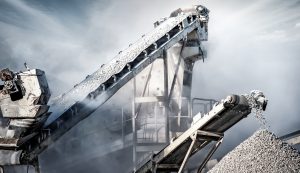
Bulk solids material handling equipment are used to store, move, and process raw materials and products. They speed up production and ensure that bulk materials can be handled in a safe and sanitary way.
The first bulk solids material handling equipment dates back to 1795: a primitive conveyor belt made of leather and a wooden bed that was used to transport grains and mining materials. Today, the equipment has become faster, more durable, and more precise. The latest automated systems even use machine learning and motion sensor technology and require very minimal human intervention.
Here are some of the most commonly used bulk solids material handling equipment that can be found in almost any processing facility that handles large volumes of material.
Hoppers and chutes
Hoppers and chutes are used to automatically feed material into the production line for further processing. They are usually connected to other bulk solids handling equipment such as conveyors, crushers, mixers, or dryers.
Hoppers are typically set up to allow a controlled feed rate, but material blocks can slow down the discharge or even stop it completely. That is why it is necessary to understand the material flow properties, select the right hopper angle and outlet size, and install a reliable flow aid like AirSweep.
Silos
Silos are used for storing bulk materials. These are typically used for food and agricultural products, but can also hold other bulk solids like cement materials, sawdust, woodchips, metal waste, and chemicals like carbon black and aluminum oxide.
The terms silos and hoppers are often used interchangeably, although there are distinct differences between these two bulk solids handling equipment. Watch this video on silos vs hoppers.
Conveyors
Conveyors are used to transport bulk materials or goods. Most conveyors still use the traditional belt design. Some applications use pulleys or buckets or have cleated surfaces to keep materials secure or evenly spaced.
When choosing the right conveyor (or any bulk solids handling equipment), users must consider the bulk material’s dimensions, weight, and fragility, as well as the plant environment like risk for corrosion and available space.
Conveyors and other bulk solids material handling equipment used for transporting materials such as bucket elevators will always have a risk for material spills. This typically occurs when one of the parts malfunction and cause the conveyor to run faster or slower than intended.
A DAZIC Zero Speed Switch can be installed into the conveyor or transport system to detect abnormal speeds and signal the operator before a spill occurs.
Stackers
Stackers are used to lift and stack heavy loads on warehouses and docks. Some warehouse automation systems combine stackers with autonomous shelf loader robots and shuttles, or systems that track inventory and coordinated routing. (Read our article on Top 5 Technologies for Automated Bulk Material Handling.)
Reclaimers
One of the largest bulk solids handling equipment, reclaimers are used to recover bulk materials from a stockpile. They typically consist of a bucket-wheel, counterweight boom, rocker, and a conveyor system.
Both stackers and reclaimers are used extensively in the mined minerals industry or other applications that have to gather raw materials from piles before redistributing them for shipment or processing.
Protect material flow in bulk solids handling equipment
Materials can often settle during storage, or develop flow problems during transportation and processing. AirSweep can help activate material to prevent material blocks or correct erratic flow.
AirSweep can be installed on any bulk solids handling equipment– silos, hoppers, conveyors, bucket elevators, or any vessel where material can hang up. Contact us to find out more about how to use AirSweep in your system.





Comments are closed